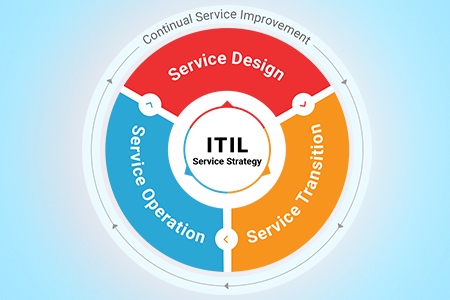ITIL is the comprehensive approach that concerns with ITSM (known as IT Service Management). As per the number of users, using this comprehensive approach; business execution can enhance a high scale.
It provides the structure in business that further helps to recognize, plan, convey and assist IT services. Also, it includes standard sets which are made such that it assures that IT services can satisfy every one of the needs of the business.
Because of such effect in business, various expansive corporations around the world are implementing this training. Also, IT Infrastructure library is profitable for medium-sized and small companies because it helps in applying the down to earth approach to IT service management. When it appropriately executed, ITIL practices empower your business to convey powerful services to customers. Also, it supports in meeting business goals.
With the developing implementation of ITIL in business also raises the interest of ITIL professional in the organization. An affirmed professional because, at some instance, the person with ITIL Certification holds the learning and appropriate understanding of each phase in ITIL.
The employer’s who implementing ITIL to oversee IT service of their business have more confidence in ITIL ensured professional. As a result, these days IT professional are inclining more towards the ITIL certification. A new kid on the block or master in IT, everybody attempting to include ITIL certification in their resume.
How about we push ahead and understand the ITIL basics, its significant benefits, and how you can present its practices inside your business.
5 Basic Elements of ITIL

The service lifecycle, we must start from here to understand “what really is ITIL?”. For IT services, ITIL is one of the bound together, start to finish solutions. It is responsible for addressing the service issues from its introduction to completion and covering every step in the middle.
Additionally, the service lifecycle holds the free modules, and these modules are really created by focusing on center titles of ITIL. Also, these modules are:
1. Service Operation
This module of service lifecycle is responsible for conveying services and observing service success and disappointment once a day. Also, it is responsible for keeping up the service wellbeing that includes systems restoration after errors.
2. Service Design
This module makes sure that any recently included or modified services must be designed to meet the expectations of the customer’s in a cost-viable manner. It makes sure that each useful innovation, service design, process productivity, and service management systems must take into consideration.
3. Service Transition
This lifecycle phase is responsible for the structure, testing and implementing services in the creation for the business clients. Here administrators perform necessary changes, service approval and assign the essential personnel for production.
4. Service Strategy
The accompanying module is assigned to understand the organization IT customers. By understanding, it means understanding customers need and what IT services are sufficiently productive to give them and necessity that helps in successful execution.
5. CSI
Continual Service Improvement (CSI) is a big motivator for it. It enables the path for the IT staff, using which IT staff ceaselessly improve and measure their service quality. Also, it makes sure that innovation must be updated and entire services must be managed properly.
Implementation of ITIL Into Your Business Processes
On the off chance that you are anticipating implementing ITIL in your business, at that point ensure that you investigated the processes which get profited by ITIL; also your employees can easily foresee its impact on your business.
Also, build up a report holding the existing work practices, objectives, and set goals and later incorporate the services that require improvements. Investigate any gaps between your existing services and goals you chose for an upgrade. It will assist your group in identifying the best possible strategies.
Finally, take a decision that concern your methods chose for management of task, timelines, charts and different tools identified with venture management. After the implementation of IT Infrastructure Library, make a point to screen improvements and service strategies for a change that you have to make.
When you understand ITIL, its benefits, lifecycle, and starting steps required for implementation, at that point you easily choose; in the case of using it directly for your business or not. Also, having ITIL instead of ITSM will enable IT to staff to fix problems faster, improve your focus for accomplishing business goals.
5 Benefits of IT Infrastructure Library

There are various benefits of implementing ITIL, and because of these benefits, ITIL is getting received by increasingly more organization of different scale (small, average sized, and extensive). Further, shown underneath are the main benefits of ITIL:
1. Organization’s Positive Transformation
Practices of ITIL administration lifecycle require the movement of the most astounding a motivating force for the customer at each dimension.
This way, using the acts of ITIL empowers your business to even more successfully handles supervise customers portfolios and accomplish the central positive difference in the association itself that you can measure.
2. Improved Client Satisfaction
It may give off an impression of being silly; be that as it may, ITIL not focuses on inventive issues. Somewhat, it focuses on the requirements of the customer experience. The best practices of ITIL helps in dealing with the organization to convey products and services for clients in a successful way that could be accessible.
So, how do organizations benefit by this? They improve customer satisfaction rates, pull in more clients, and urge to manufacture all the more trusting relationships.
3. Diminished Recovery Time and Enhanced Service Delivery
When you drive business, it’s essential to transfer your services skillfully, dependable, and inside a characterized time to customers. Implementing standards of IT Infrastructure Library implies that your association can support the method for conveying services to beneficiaries.
Besides, your organization can ricochet back faster from downtime, because of transparency in the streamlined processes. Implementing the best practices of ITIL indicates that you will ready to comply with the time constraints of the services; also convey a quality item generally speaking.
4. Extensive Optimization Enhancement
For upgrading the organization’s profitability streamlining plays a viable job in it. ITIL gives the techniques and practices that assist suppliers in working and settling on intelligent business decisions.
It introduces the best and pivotal practices for applying an obvious approach of promoting standards with overall partners, alongside upgrade in money related opportunities and improving the risk management guideline.
5. Headway with Current Trends
The certifiable reason that IT Infrastructure Library is so suitable is that it takes standard practices all through the IT service official practice and merges them.
These practices are capably combined with a ton of joined acknowledged procedures for organizations to even more adequately pursue and refresh.
They ceaselessly advance and upgrade as patterns change. Soon it adjusts itself to the repetitive example of corporate needs wherever on the planet similarly, as ITIL makes itself business dynamic so your business (for most extraordinary skills).
Final Remarks
The ITIL is an approach that will be embraced by almost every organization later on; it is because of enormous benefits which are characterized here in the article. The benefits of ITIL will assist you with understanding “how business take profit by ITIL?”. Also, if you hold business and desires to execute ITIL, at that point, you can experience the implementation of ITIL in a word.
Author: Danish Wadhwa
















